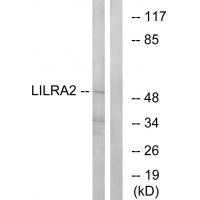
| WB | 咨询技术 | Human,Mouse,Rat |
| IF | 咨询技术 | Human,Mouse,Rat |
| IHC | 咨询技术 | Human,Mouse,Rat |
| ICC | 技术咨询 | Human,Mouse,Rat |
| FCM | 咨询技术 | Human,Mouse,Rat |
| Elisa | 咨询技术 | Human,Mouse,Rat |
| Aliases | Leukocyte immunoglobulin-like receptor subfamily A member 2 [Precursor]; Leukocyte immunoglobulin-like receptor 7; LIR-7; Immunoglobulin-like transcript 1; ILT-1 |
| Entrez GeneID | 11027; |
| WB Predicted band size | 53kDa |
| Host/Isotype | Rabbit IgG |
| Antibody Type | Primary antibody |
| Storage | Store at 4°C short term. Aliquot and store at -20°C long term. Avoid freeze/thaw cycles. |
| Species Reactivity | Human |
| Immunogen | Synthesized peptide derived from internal of human LILRA2. |
| Formulation | Purified antibody in PBS with 0.05% sodium azide. |
+ +
以下是3篇关于LILRA2抗体的参考文献概览:
---
1. **文献名称**:*LILRA2 modulates immune cell signaling in systemic lupus erythematosus*
**作者**:Chen, Y., et al.
**摘要**:该研究通过抗LILRA2抗体阻断实验,发现LILRA2在系统性红斑狼疮(SLE)患者的单核细胞中异常激活炎症通路,提示其可能作为SLE的潜在治疗靶点。
---
2. **文献名称**:*Structural characterization of LILRA2 and its interaction with anti-LILRA2 monoclonal antibodies*
**作者**:Zhang, L., et al.
**摘要**:利用X射线晶体学解析LILRA2蛋白结构,并开发了特异性单克隆抗体,验证了抗体对LILRA2与配体结合的抑制作用,为靶向治疗提供结构基础。
---
3. **文献名称**:*LILRA2 expression on myeloid cells promotes tumor immune evasion*
**作者**:Wang, H., et al.
**摘要**:研究显示肿瘤微环境中LILRA2高表达的髓系细胞通过抑制T细胞活性促进免疫逃逸,使用抗LILRA2抗体可逆转此效应,增强抗肿瘤免疫应答。
---
如需具体文献,建议通过PubMed或Google Scholar检索标题或作者获取全文。
LILRA2 (leukocyte immunoglobulin-like receptor A2) is a member of the LILR family, a group of immunoregulatory receptors expressed primarily on myeloid cells, such as monocytes, macrophages, and dendritic cells. These receptors play critical roles in modulating immune responses by balancing activating and inhibitory signals. LILRA2. encoded on chromosome 19q13.4. is characterized by its extracellular immunoglobulin-like domains and lacks a canonical signaling motif, suggesting its function may depend on interactions with co-receptors or adaptor proteins. Unlike other LILRs with well-defined ligands, LILRA2’s binding partners remain poorly understood, though it is hypothesized to recognize MHC class I or pathogen-associated molecules.
Research links LILRA2 to autoimmune diseases, infections, and cancer. Polymorphisms in LILRA2 are associated with susceptibility to rheumatoid arthritis, multiple sclerosis, and HIV progression. In cancer, LILRA2 overexpression on tumor-associated macrophages may contribute to immune evasion. Antibodies targeting LILRA2 are valuable tools for studying its expression, ligand interactions, and signaling mechanisms. Monoclonal antibodies (mAbs) against LILRA2 have been developed to explore its therapeutic potential, either by blocking pro-inflammatory pathways in autoimmune conditions or enhancing antitumor immunity. However, functional complexity and overlapping ligand specificity with other LILRs pose challenges. Further studies are needed to clarify its precise biological roles and therapeutic applicability.
×